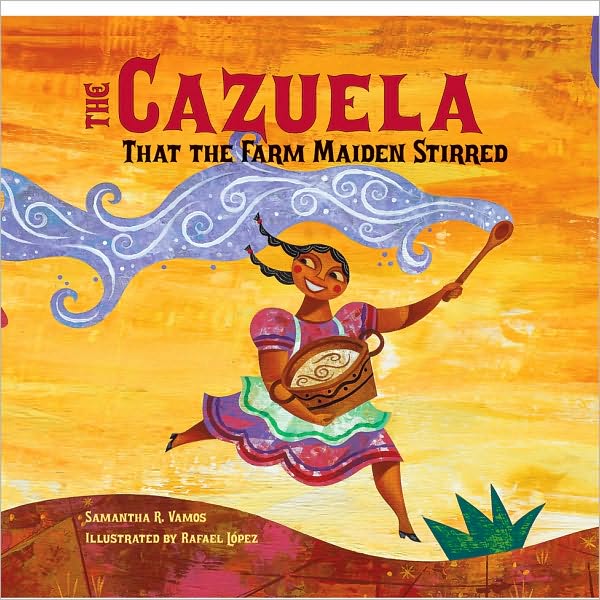

In the book The Cazuela that the Farm Maiden Stirred by Samantha R. Vamos, illustrated by Rafael López, the story builds up through repetition, like “The House that Jack Built.” This cumulative form is ideal for a story about making a recipe, and for teaching us all some Spanish words (there’s also a glossary at the back). Best of all, the results of the recipe are a surprise! Here Samantha Vamos talks about how a cold Chicago day planted the seeds for her heartwarming tale of many farm hands (and hooves) that come together to make a wonderful meal.
How did you come up with the idea for The Cazuela that the Farm Maiden Stirred?
We were living in Chicago in a frontier area of the city and didn’t have a car. I wanted to make pancakes, but I didn’t have two crucial ingredients: milk and eggs. In order to get them, I’d have to take a taxi or a bus, but it was bitterly cold. I thought about how great it would be to live on a farm. I’d be the farm maiden and I’d ring the cow and say, “Could I have some freshly given milk?” I did have a pot, and this line came to me, “This is the cazuela that the farm maiden stirred.” The rhythm reminded me of “This Is the House that Jack Built.” I never made the pancakes, but I did finish writing a first draft of the story.
We liked the way you taught us Spanish words through the repetition of the story’s events.
I wanted the story to be bilingual, and I always wanted to write a book with a recipe. I needed to create specific characters to bring a different ingredient. The cow and chicken were obvious choices. “The House that Jack Built” structure was the perfect way for the Spanish words to be incorporated and remembered, since they’re repeated. Organically, it just kind of flowed.
We liked the part where the cow is teaching the cabra (goat) how to make mantequilla (butter) with her own milk!
As I thought about it, I needed to have some transition, I needed to have action animals to advance the story. It made sense to me that the cow would teach the goat. I didn’t know Rafael would put a toque [chef’s hat] on the goat’s head!
We also liked when the duck (pato) rides the burro (donkey) to the mercado (market) to buy azúcar (sugar) for the recipe. At first, we didn’t notice the burro’s back!
We had that experience here too! I didn’t see any of Rafael’s early work; I saw it when it was ready to go to the printer. I was looking at that page, and I loved the colors. He draws a black line as if it’s a coloring page, and then paints them in. You see a lot of lines because he paints on wood. So I was turning the page, and for me it was the same! I thought, “He’s riding on the back of the burro!” But I only saw that on the second or third reading. I loved that the burro has boots.
Another thing Rafael did is he made the sun look different in–I think–eight different images, sometimes laughing, sometimes winking. The sun is on each page when the duck appears.
Most of the characters had not one but two jobs to do to make the meal. It’s kind of the opposite of The Little Red Hen, isn’t it?
In The Little Red Hen, the animals aren’t mean, but they’re eating on their own, it’s kind of lonely. I’m not trying to pat myself on the back, but I like that, in this story, the animals are doing things and participating. It’s only natural that they’d enjoy the meal because they deserve to.
Samantha Vamos and her publisher, Charlesbridge, have created an activity guide with ideas that you can do together with your youngster to extend the book’s themes, from math to Bingo cards featuring the Spanish/English words used in the story. Rafael López did the illustrations. Read or BookChat with this fantastic children’s book for free on Readeo during May!
Jenny Brown is the editor for Readeo and oversees all book selection for the site. She has worked in the children’s book world for the past 25 years, holding positions with HarperCollins and Scholastic, and was the Children’s Books Reviews Editor for Publishers Weekly. She currently writes for School Library Journal, Kirkus Reviews, and Shelf Awareness. Jenny graduated from Princeton University. You can read more from Jenny on her Web site, Twenty by Jenny.

I wish I had thought of something like this! It is so simple an idea but so beautiful. Kudos to the artist too for bringing it all to life!
It was delightful to speak with you, Jenny. Thank you for a wonderful interview.
Dear Samantha, I felt the exact same way about speaking with you! You certainly make a case for being snowbound! With all my best, Jenny